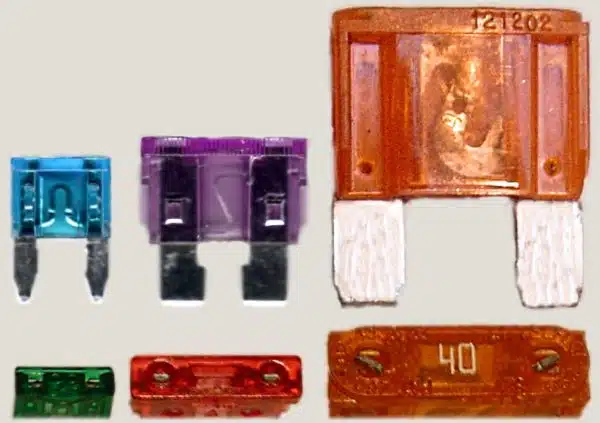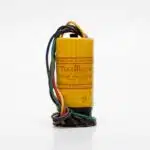Screw-in plug fuses are commonly used in homes and commercial buildings as a safety device to prevent electrical overloads. However, they can fail over time due to wear and tear or the occasional power surge. It is essential to test screw-in plug fuses periodically to ensure that they are functioning correctly, preventing electrical fires and other hazards.
As an electrical engineer, it is crucial to understand how these fuses work and how to test them accurately. This article aims to provide a comprehensive guide on testing screw-in plug fuses for anyone seeking knowledge on the topic. By following the steps outlined in this article, you will be able to identify faulty fuses promptly, ensuring your safety and that of others who may come into contact with any electrical equipment that uses these types of fuses.
Understanding The Function Of Screw-In Plug Fuses
Screw-in plug fuses are important components of electrical systems. They play an important role in preventing electrical fires and other hazards. Understanding how these fuses function and how to maintain them is crucial for ensuring fuse safety.
Screw-in plug fuses are designed to protect electrical appliances from over-currents or short-circuits. Essentially, they work by breaking the circuit when the current exceeds a certain level. This prevents overheating and damage to the appliance. Screw-in plug fuses have a metal filament that melts when exposed to excessive current flow, thereby disrupting the electrical circuit.
To ensure proper functioning of screw-in plug fuses, regular maintenance is necessary. One key maintenance tip is to replace blown fuses immediately with ones rated for the same amperage as the original fuse. Additionally, it is important to check for any signs of wear or corrosion on the fuse holder and threads, as this can cause poor contact between the fuse and holder. Proper maintenance ensures that screw-in plug fuses operate safely and effectively, protecting both people and equipment from harm.
Understanding how screw-in plug fuses function and maintaining them properly is vital for ensuring safety in electrical systems. In order to choose the right type of screw-in plug fuse for your system, it is important to know about different types available on the market.
Types Of Screw-In Plug Fuses
Screw-in plug fuses are electrical safety devices that are rated based on two criteria: amp ratings and voltage ratings. Amp ratings refer to the maximum current that a fuse can handle without breaking the circuit, and voltage ratings refer to the maximum voltage that a fuse can handle safely. It is important to select a fuse with the appropriate amp and voltage ratings to ensure safe operation. Testing a screw-in plug fuse requires a multimeter to measure the continuity of the fuse.
Amp Ratings
As electrical engineers, we understand the importance of ensuring that the electrical systems in our homes and workplaces are functioning optimally. One key component of these systems is screw-in plug fuses, which protect the circuits from overloading and causing damage. When selecting the right type of screw-in plug fuse for your system, amp ratings are a crucial consideration.
The amp rating indicates the maximum amount of current that a fuse can handle before it blows. It’s important to choose a fuse with an appropriate amp rating for your circuit, as using one with too low an amp rating could cause it to blow prematurely and interrupt power supply unnecessarily. On the other hand, using one with too high an amp rating could lead to overheating and even fire hazards.
Fuse capacity differences also come into play when choosing the right type of screw-in plug fuse. For instance, a type S fuse has a higher capacity than a type W fuse, meaning it can handle more current without blowing. However, this doesn’t mean you should use a type S fuse on any circuit – always check the manufacturer’s guidelines and use a fuse with the correct amp rating for your specific application.
In conclusion, selecting the right type of screw-in plug fuse involves careful consideration of both its amp rating and capacity differences. As electrical engineers committed to serving others through our work, it’s important that we take these factors seriously to ensure safe and efficient operation of our electrical systems.
Voltage Ratings
When it comes to selecting the right type of screw-in plug fuse, there are several important factors to consider. One such factor is voltage ratings, which refer to the maximum voltage that a fuse can safely handle. It’s crucial to choose a fuse with an appropriate voltage rating for your specific application, as using one with too low a rating could cause it to fail and interrupt power supply unnecessarily.
In addition to considering voltage ratings when selecting a screw-in plug fuse, it’s also important to be aware of testing procedures. Before installing a new fuse, it’s essential to test it thoroughly to ensure that it will function properly in your electrical system. This involves checking its continuity and resistance levels, as well as ensuring that it has the correct amp rating and capacity for your circuit.
Overall, selecting the right type of screw-in plug fuse requires careful consideration of several key factors, including voltage ratings and testing procedures. As electrical engineers committed to serving others through our work, we must always prioritize safety and efficiency in our decision-making processes. By taking these factors seriously and being diligent in our approach, we can help ensure that our electrical systems operate optimally and reliably in any setting.
Tools Needed For Testing Screw-In Plug Fuses
To test screw-in plug fuses, you will need a few essential tools. First, get a voltage tester or a multimeter that can measure continuity and resistance. Secondly, you will need a screwdriver to remove the fuse from its socket. Lastly, a flashlight may be necessary for checking the fuse’s condition.
There are different testing methods available for screw-in plug fuses. One way is to use a continuity tester to check whether the fuse’s filament is intact or not. Another method is to check the resistance of the fuse with a multimeter. If the fuse has no continuity or high resistance, it is likely faulty and needs replacement.
If your tests reveal that the screw-in plug fuse is not functioning correctly, then some troubleshooting techniques can help diagnose what went wrong. Check for any visible signs of damage such as cracks, blackening or scorching on the exterior body of the fuse. Also, ensure that there is no loose connection between the fuse and its socket.
Moving forward into safety precautions before testing screw-in plug fuses, keep in mind that electrical safety should always come first when working with electricity. Before starting any repair work on electrical systems, make sure power sources are turned off and disconnected from their source. Failure to follow these steps can lead to severe injuries or even death due to electric shock hazards.
Safety Precautions Before Testing Screw-In Plug Fuses
- Prior to testing screw-in plug fuses, it is essential to gather the necessary tools such as a screwdriver, flashlight, and voltage tester.
- After the necessary tools are gathered, power to the circuit should be shut off at the circuit breaker box.
- It is also important to ensure that the power is off by using the voltage tester to confirm the lack of voltage in the circuit.
- In order to maintain a safe environment, protective gear such as safety goggles and rubber gloves should be worn at all times.
- To further ensure safety, the fuse should be disconnected from the circuit before testing.
- During the test, it is essential that the screw-in plug fuse is not touched with bare hands as this could cause an electric shock.
Gather Tools
To ensure safety when testing screw-in plug fuses, gathering the right tools is crucial. Using a multimeter can help detect any voltage and current problems in the electrical circuit. This device can measure both AC and DC voltage, as well as current in amperes. Make sure to have a functioning multimeter before proceeding with testing.
Identifying the fuse rating is also important before testing. The rating is usually printed on the fuse itself or on its packaging. It indicates the amount of amperage that the fuse can handle before it blows out. Testing a lower-rated fuse with higher amperage could cause a dangerous overload in the electrical system, potentially causing damage to appliances or even starting a fire.
In summary, using a multimeter and identifying the fuse rating are essential steps in ensuring proper safety precautions when testing screw-in plug fuses. Without these tools, one runs the risk of damaging their electrical system or causing harm to themselves or others. Always take these precautions seriously when working with electricity to prevent accidents and injuries.
Turn Off Power
Before testing screw-in plug fuses, it is crucial to take the necessary safety precautions. One of the essential steps in ensuring safe fuse removal is to turn off power to the electrical circuit. This precaution prevents electric shocks when handling live wires during the fuse replacement process. As an electrical engineer, it is vital to emphasize that one should never attempt to remove or replace a fuse with live power running through it.
To turn off power to an electrical circuit, locate the main circuit breaker panel and switch off the corresponding breaker for the circuit being worked on. Alternatively, one can turn off power by unplugging appliances and devices connected to the circuit. It is crucial to test whether power has been successfully disconnected using a multimeter before proceeding with fuse removal.
Even after turning off power, precautions for handling live wires are necessary. Avoid touching any exposed wires or components and use insulated tools when working within an electrical system. As an engineer, it is critical always to prioritize safety when working with electricity and ensure that all safety measures have been taken before starting any work on an electrical system. Remember, accidents can be prevented by following these simple yet effective precautions.
Wear Protective Gear
Another crucial safety measure to consider before testing screw-in plug fuses is to wear protective gear. This precaution helps prevent injuries in case of an accident during the fuse replacement process. As an electrical engineer, it is vital to emphasize that protective gear should never be overlooked when working with electricity. Protective gear includes gloves, safety glasses, and clothing made of non-conductive materials.
One factor that makes wearing protective gear important is visibility. When handling live wires or other electrical components, one may inadvertently touch them due to poor visibility. Wearing safety glasses can help protect against debris flying into one’s eyes, while gloves can prevent contact with live wires and other conductive elements. Additionally, appropriate clothing made of non-conductive materials can provide insulation against electric shocks.
Proper handling techniques are also essential when wearing protective gear. When working within an electrical system, it is crucial to avoid touching any exposed wires or components with bare hands or tools without proper insulation. Careful attention must be paid to the removal and installation of fuses to ensure that the task is completed safely and efficiently. Ultimately, taking these precautions helps prevent accidents and ensures a safer work environment for all involved parties.
Step-By-Step Guide To Testing Screw-In Plug Fuses
After taking the necessary safety precautions, it is time to test your screw-in plug fuses. Proper testing techniques can ensure that your fuses are in good condition and will provide the necessary protection for your electrical system. Troubleshooting tips can help you identify any issues that may arise during testing.
To begin testing, you will need a multimeter with a continuity setting and a voltage setting. Start by turning off power to the circuit you are testing and removing the fuse from its socket. Use the multimeter’s continuity setting to check if there is continuity between the two metal ends of the fuse. If there is no continuity, replace the fuse with one of the same amperage rating.
If there is continuity, use the multimeter’s voltage setting to check if there is voltage on both sides of the fuse. If there is no voltage on one side but there is on the other, this indicates a blown fuse and it should be replaced. If there is no voltage on either side, this could indicate a problem with the circuit or wiring and further troubleshooting may be necessary.
- When testing for continuity, use caution as live wires may still be present in some parts of the circuit.
- Always use a multimeter with appropriate settings and follow manufacturer instructions.
- Keep spare fuses on hand in case replacements are needed.
- Regularly test your fuses to ensure they are providing adequate protection for your electrical system.
In summary, proper testing techniques can ensure that screw-in plug fuses are functioning properly and providing protection for your electrical system. Troubleshooting tips can help identify issues during testing and provide solutions to keep your system safe. Remember to always take necessary safety precautions when working with electricity and have spare fuses available for replacement if needed.
Testing For Continuity
When it comes to testing screw-in plug fuses, measuring continuity is a crucial process. Continuity refers to the ability of an electrical circuit to conduct electricity without interruption. If there is no continuity, it means that the circuit is broken and needs to be repaired or replaced. To test for continuity, you will need a multimeter that measures resistance.
To begin measuring continuity, set your multimeter to the resistance or ohms setting. Next, touch one probe of the multimeter to the center contact of the fuse and touch the other probe to the threaded metal base of the fuse. If there is continuity, your multimeter should display a reading of zero ohms or close to zero ohms. On the other hand, if there is no continuity, your multimeter will display an infinite reading which indicates that there is a break in the circuit.
Interpreting results can be tricky because some fuses may have different resistances depending on their rated amperage and manufacturer specifications. It’s essential to refer to the manufacturer’s instructions or seek advice from a licensed electrician when interpreting results. Also, bear in mind that if your fuse shows signs of physical damage such as cracks or burn marks, it needs replacement regardless of its measured resistance value.
In summary, measuring continuity with a multimeter is an effective way to test screw-in plug fuses for faults or breaks in electrical circuits. Interpreting results can be challenging due to differences in resistance values among various types of fuses; hence proper reference documentation must be used when interpreting these results. In our next section, we will discuss how to test for resistance and its importance in electrical testing processes without discontinuity between paragraphs.
Testing For Resistance
Although screw-in plug fuses are designed to protect electrical appliances from power surges, they may eventually wear out and require replacement. Therefore, it is important to know how to test these fuses for resistance regularly. This will help you determine if the fuse is still functional or needs replacement.
To measure the resistance of a screw-in plug fuse, you need a multimeter. First, switch off the power supply before testing the fuse. Then, set your multimeter to measure resistance and touch its probes on opposite ends of the fuse. If your multimeter displays a reading of 0 ohms, this means that the circuit is complete and that there is no resistance across the fuse. Conversely, if the reading is infinite or very high, this indicates an open circuit which means that no current can flow through it.
Interpreting results from testing screw-in plug fuses for resistance should be done with caution as it may not always indicate a failed fuse. A low or zero reading suggests that the circuit has continuity and that there’s no resistance in the wire, while a high or infinite reading indicates an open circuit where there’s an interruption in continuity due to a blown-up or defective fuse. It’s vital to note that other factors could influence these readings such as corrosion on contact points, loose wiring connections, among others – thus requiring further investigation before replacing a suspected bad fuse.
Transitioning into testing for grounding: Another important step after testing screw-in plug fuses for resistance is checking if they’re properly grounded. This ensures safety by preventing electric shocks caused by exposed wires and helps dissipate excess voltage safely away from appliances in case of power surges or lightning strikes.
Testing For Grounding
Resistance testing is an essential technique for determining the functionality of electrical devices. However, it is not enough to ensure that the device is safe to use. Grounding techniques must also be applied to prevent electrocution or electrical shock. Faulty grounding can cause serious hazards and should be identified before using any equipment.
Grounding techniques involve connecting the electrical device to a grounded conductor, such as a metal pipe or rod in contact with the earth’s surface. This connection ensures that in case of a short circuit or leakage current, the excess current will travel through this path instead of passing through the user’s body. Identifying faulty grounding involves checking for continuity between different parts of the device and the ground. This can be done using a multimeter or other specialized equipment.
Screw-in plug fuses are common components used in electrical circuits to protect against overcurrents. However, they are prone to issues such as loose connections, corroded contacts, and blown fuses due to excessive current passing through them. These issues can lead to power outages or even fires if left unchecked. Therefore, regular inspection and testing of screw-in plug fuses are necessary to ensure their proper functioning and prevent hazardous situations from occurring.
Common Issues With Screw-In Plug Fuses
Screw-in plug fuses are commonly used in residential and commercial electrical systems to protect appliances and devices from voltage spikes. However, these fuses can fail due to various reasons, causing power outages or even fires. It is crucial to identify the causes of failure and signs of damage to prevent such incidents from occurring.
One of the leading causes of screw-in plug fuse failure is overload. If too many devices are connected to a single circuit, it can cause an overload that exceeds the fuse’s capacity, leading to it blowing out. Similarly, if an appliance draws more current than what the fuse can handle, it can cause the fuse to fail. Additionally, overheating due to loose connections or damaged wiring could also cause a fuse failure.
Signs of damage on screw-in plug fuses include discoloration or charring around the base of the fuse. This indicates that there has been excessive heat generated in that area and could lead to a fire hazard if left unchecked. Another sign could be visible cracks or breaks on the body of the fuse. This could mean that there was physical stress placed on the fuse due to external factors such as impact or vibration.
In summary, understanding common issues with screw-in plug fuses is essential for ensuring a safe and reliable electrical system. Causes of failure such as overload and overheating must be identified and addressed promptly. Signs of damage such as discoloration or visible cracks should not be ignored and require immediate attention before further damage occurs. In the next section, we will discuss troubleshooting faulty fuses by examining their symptoms and possible solutions.
Troubleshooting Faulty Fuses
To ensure proper functioning of electrical appliances, it is essential to check the screw-in plug fuses regularly to detect any faults. Faulty fuses can cause electrical hazards and damage to the appliance. Therefore, troubleshooting faulty fuses should be a part of every homeowner’s maintenance routine.
The process of checking screw-in plug fuses involves two steps- Identifying fuse ratings and Checking voltage. The fuse rating indicates the amount of current that can pass through it before blowing up. A wrong rating can cause a blown fuse or damage to the appliance. Similarly, checking voltage ensures that the correct voltage is supplied to the appliance as per its specifications.
To troubleshoot faulty fuses, homeowners can follow these simple steps:
- Turn off all appliances connected to the circuit.
- Remove the fuse and replace it with one that has a similar rating.
- Turn on all appliances connected to the circuit.
- Check if they are working correctly.
By following these steps, homeowners can quickly identify and resolve issues with their screw-in plug fuses without professional help. However, if a fault persists even after replacing a faulty fuse, it is advisable to consult an electrician for further assistance.
Replacing Faulty Fuses
If your electrical system is not functioning correctly, it may be due to a blown fuse. Replacing fuses is a simple task that can be done yourself with the right tools and knowledge. Before starting DIY fuse replacement, it is important to understand the different types of fuses available in the market.
Screw-in plug fuses are one of the most commonly used types of fuses in household electrical systems. To replace a faulty screw-in plug fuse, you should start by turning off the main power supply to your home. Locate the fuse box and remove the cover to access the blown fuse. Use a multimeter or continuity tester to check if the fuse is faulty. If it has failed, unscrew it from its socket and replace it with a new one of identical amperage rating.
In conclusion, replacing faulty fuses is an essential aspect of maintaining your home’s electrical system. Taking on this task yourself can save you time and money compared to hiring an electrician. However, always prioritize safety when dealing with electrical components by turning off power sources before attempting any repairs. Next, let us discuss why regular testing of your fuses is critical for preventing electrical hazards and damage to your appliances and electronics.
Importance Of Regular Fuse Testing
Although many homeowners may overlook the importance of regular fuse testing, it is crucial to ensure that your electrical system remains safe and functional. Neglecting fuse maintenance can lead to serious consequences such as power outages, electrical fires, and even electrocution. Therefore, it is important to understand the benefits of regular fuse testing and to take action accordingly.
Regular fuse testing offers numerous benefits for homeowners. By identifying any potential issues early on, you can avoid costly repairs or replacements down the line. Additionally, regular maintenance can help extend the lifespan of your fuses and prevent unexpected failures. This not only saves you money but also gives you peace of mind knowing that your electrical system is in good condition.
On the other hand, neglecting fuse maintenance can have serious consequences. Fuses that are not regularly tested can become overloaded with current and fail unexpectedly. This can result in power outages or even electrical fires which put your family’s safety at risk. Furthermore, attempting to fix these issues without proper knowledge or training can lead to electrocution or further damage to your electrical system.
It is important to prioritize regular fuse testing as part of your overall home maintenance routine. However, if you do encounter any issues with your fuses or electrical system, it is important to know when to call a professional electrician for assistance.
When To Call A Professional Electrician
When considering when to call a professional electrician, damaged wiring can be a major indicator that an expert should be consulted. If a circuit breaker is frequently tripping, it is likely a sign of an overloaded circuit or a defective breaker and an electrician should be contacted. If a screw-in plug fuse is suspected, it is important to test it for continuity first before calling a professional electrician. Conversely, if the fuse is found to be defective, a professional electrician should be contacted to replace the fuse.
Damaged Wiring
As an electrical engineer, it is important to emphasize the significance of checking wiring when it comes to ensuring safety in a household. Identifying damaged wiring should not be taken lightly, as it poses a great risk for fires and electrocution. It is crucial to understand that damaged wiring can come in different forms, such as frayed or exposed wires, overheating outlets, and circuit breakers that frequently trip.
To identify damaged wiring, one must first conduct a thorough inspection of all electrical components within the household. This includes examining the electrical panel and all wiring connections throughout the house. If there are any signs of damage or wear and tear such as discoloration or burn marks on outlets, switches or receptacles, this is an indication that there may be underlying issues with the wiring. In such cases, it is highly recommended to call a professional electrician.
In conclusion, identifying damaged wiring is not something that should be taken lightly by homeowners. It requires attention to detail and knowledge of what to look out for in order to ensure safety within the home. When in doubt about any electrical issues especially related to damaged wiring or other potential hazards, it’s always best to seek professional help from an experienced electrician who can diagnose problems accurately and provide effective solutions.
Circuit Breaker Tripping
Circuit breaker tripping is a common issue that homeowners face. It occurs when the circuit becomes overloaded, causing the circuit breaker to automatically shut off to prevent any potential damage or harm. Common causes of circuit breaker tripping include using too many appliances or electronics on one circuit, faulty wiring, and outdated electrical panels. To prevent circuit breaker tripping, it is important to distribute power usage evenly throughout the home by avoiding overloading circuits and investing in updated electrical equipment.
If circuit breaker tripping continues to occur despite preventative measures taken, troubleshooting techniques can be used to identify the root cause of the problem. One solution may be to install additional circuits or upgrade existing ones to handle increased electrical demand. Another solution could involve replacing old or damaged wiring that may be causing issues with overloading. If these solutions do not work, it is strongly advised to call a professional electrician for further assistance.
When experiencing frequent circuit breaker tripping, it’s important not to ignore the issue as it can lead to major safety concerns such as fire hazards and electrocution. By being aware of common causes and prevention methods, homeowners can take proactive steps towards ensuring their electrical systems are functioning efficiently and safely. However, if troubleshooting techniques fail, seeking help from a professional electrician should not be delayed in order to avoid putting oneself at risk.
Frequently Asked Questions About Screw-In Plug Fuses
FAQs about Screw-in Plug Fuses
Screw-in plug fuses are commonly used in residential electrical systems to protect appliances and other devices from overvoltage. However, despite their importance, these types of fuses can encounter problems that may compromise their functionality over time. Here are some frequently asked questions about screw-in plug fuses.
One of the most common issues with screw-in plug fuses is when they blow out or burn. This usually happens when there is an excessive flow of current through the fuse due to a short circuit or overload. When this occurs, it is important to replace the fuse with one that has the same rating as the original one. Failure to do so may result in damage to your electrical system or cause a safety hazard.
Another issue that arises with screw-in plug fuses is testing them for continuity. To test if your screw-in fuse is working correctly, you should use a multimeter set to continuity mode. Make sure that there is no power going into the circuit before you remove and test the fuse. If your multimeter shows continuity, then your fuse works correctly. If not, then you need to replace it.
Conclusion: Stay Safe with Proper Fuse Maintenance
In conclusion, screw-in plug fuses are essential components in any electrical system that requires protection against overvoltage and electrical faults. Familiarizing yourself with common issues and performing regular checks on your system can help prevent potential hazards from arising. Remember always to follow safety protocols when dealing with electricity and never attempt repairs or modifications if you lack knowledge or experience in electrical engineering.
Conclusion: Stay Safe With Proper Fuse Maintenance
Proper fuse maintenance is essential for ensuring the safety of your electrical systems. Like the human body, electrical systems also require regular check-ups to diagnose any issues before they escalate into bigger problems. Neglecting fuse maintenance can lead to disastrous consequences, including electrical fires and property damage.
Faulty fuses are a common sign that your system requires maintenance. They can cause power outages or surges, which can damage your appliances and devices. It is crucial to look out for signs like blown fuses, flickering lights, or buzzing sounds from electrical outlets. These symptoms indicate an underlying issue that must be addressed immediately.
In summary, timely maintenance of screw-in plug fuses is critical to keep your electrical systems running safely. Proper fuse maintenance can help detect faults in the system before they become major hazards and save you significant repair costs in the long run. Therefore, it is essential to stay alert for warning signs such as blown fuses and take immediate action by calling a professional electrician. Remember: prevention is better than cure!
Conclusion
Screw-in plug fuses are an essential component of electrical systems, and their proper functioning is crucial for maintaining safety. Testing screw-in plug fuses is a straightforward process that can be done using a few tools and following specific steps. It is important to understand the different types of screw-in plug fuses available and the safety precautions necessary before testing them.
Regular fuse testing is vital in ensuring that your electrical system remains safe and functional. Neglecting to test your screw-in plug fuses can lead to serious electrical problems such as fire or electrocution. When in doubt, it is recommended that you seek the assistance of a professional electrician.
For example, suppose you are a homeowner who has been experiencing frequent power surges. You have tried replacing light bulbs and unplugging appliances but have noticed that the issue persists. Upon testing your screw-in plug fuses, you find that one of them has blown. Replacing the faulty fuse promptly solves the problem and prevents any further damage to your home’s electrical system.
In conclusion, regular maintenance of an electrical system’s screw-in plug fuses is essential for safety purposes. Homeowners should take precautions when testing screws in plug fuses by understanding their function and having appropriate tools on hand. When in doubt, it is always best to seek out professional assistance rather than risk damaging your home’s electrical system or putting yourself at risk of injury or worse.
Image Credits
- “File:Electrical fuses, plug-in type, different sizes.jpeg” by havarhen (featured)























![How To Replace A Single-Pole Wall Switch 23 '... All in all it's just another [switch] in the wall.' ...](https://green-life.blog/wp-content/uploads/2023/05/17xmP5qMtVjq-150x150.jpg.webp)





